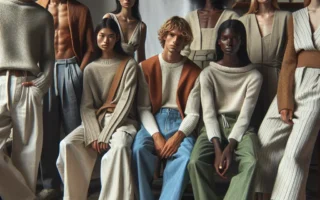From Fast Fashion to Slow Fashion: A Brief History
Sustainable fashion has been gaining momentum in recent years, shifting the focus from fast fashion to slow fashion. The evolution of sustainable fashion trends has a rich history, with the concept of slow fashion emerging as a response to the negative impacts of fast fashion on the environment and labor conditions.
Fast fashion, characterized by rapid production cycles and low-cost garments, rose to prominence in the late 20th century. This approach prioritized quantity and speed of production, leading to massive environmental pollution, exploitation of workers, and the creation of vast amounts of textile waste. As awareness of these issues grew, a countermovement began to take shape.
Slow fashion, on the other hand, emphasizes quality over quantity, sustainable materials, fair labor practices, and timeless design. This approach encourages mindful consumption and thoughtful production, promoting garments with a longer lifespan and lower environmental impact.
The transition from fast fashion to slow fashion reflects a broader societal shift towards sustainability and ethical responsibility. Consumers are increasingly seeking out brands and designers who embrace sustainable practices, leading to a rise in eco-friendly materials, ethical production methods, and transparent supply chains.
As the demand for sustainable fashion continues to grow, the industry is witnessing a transformation towards a more conscious and responsible approach. The evolution from fast fashion to slow fashion marks a pivotal moment in the history of sustainable fashion trends, highlighting the potential for positive change within the fashion industry.
Eco-Friendly Materials in Fashion: A Sustainable Shift
In recent years, the fashion industry has been experiencing a significant shift towards sustainability, with a particular focus on eco-friendly materials. This evolution reflects a growing awareness of the environmental impact of traditional fashion production methods and a desire to embrace more sustainable practices.
The use of eco-friendly materials in fashion represents a key element of this sustainable shift. Designers and brands are increasingly turning to materials such as organic cotton, linen, hemp, and recycled fibers to create clothing that minimizes harm to the environment. These materials require less water and energy to produce, and they often have a lower carbon footprint compared to conventional fabrics.
Furthermore, the development of innovative eco-friendly materials, such as Tencel and Piñatex (made from pineapple leaf fibers), offers exciting alternatives to traditional textiles. These materials not only reduce the industry’s reliance on non-renewable resources but also provide opportunities for creative and unique design possibilities.
Consumers are also becoming more discerning, actively seeking out clothing made from sustainable materials. This growing demand is prompting fashion brands to prioritize eco-friendly materials and incorporate them into their collections. As a result, sustainable fashion is no longer confined to niche markets but is increasingly becoming a mainstream movement.
In conclusion, the adoption of eco-friendly materials in fashion represents a crucial aspect of the industry’s sustainable evolution. By embracing these materials, fashion designers and brands are not only reducing their environmental impact but are also driving positive change and paving the way for a more sustainable future for the fashion industry.
The Future of Fashion: Innovations in Sustainable Design
As the fashion industry continues to move towards sustainability, innovations in sustainable design are shaping the future of fashion. Designers and brands are embracing new technologies and materials to create clothing that is both stylish and environmentally friendly.
One of the key innovations in sustainable design is the use of recycled and upcycled materials. Designers are finding creative ways to repurpose old clothing and textiles, reducing waste and minimizing the industry’s environmental impact. Additionally, advancements in textile development have led to the creation of new sustainable materials, such as fabric made from bamboo, hemp, and even pineapple leaves.
Another important aspect of sustainable design innovation is the development of eco-friendly production processes. This includes the use of non-toxic dyes, water-saving techniques, and energy-efficient manufacturing practices. By incorporating these methods, fashion brands are able to reduce their carbon footprint and minimize pollution.
Technology is also playing a crucial role in the future of sustainable fashion. From 3D printing to digital design tools, technology is helping designers create clothing with minimal waste and maximum efficiency. Furthermore, the use of blockchain technology is improving transparency in the fashion supply chain, allowing consumers to make more informed and ethical purchasing decisions.
Looking ahead, the future of fashion will undoubtedly be shaped by continued innovations in sustainable design. By prioritizing eco-friendly materials, production methods, and technologies, the fashion industry is paving the way for a more sustainable and responsible approach to clothing manufacturing and consumption.



